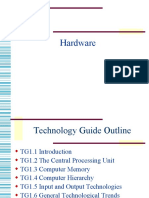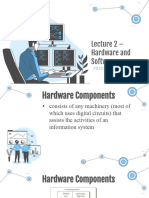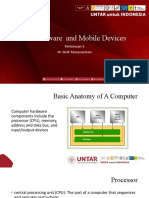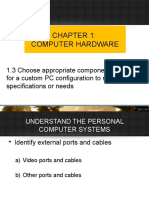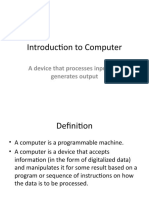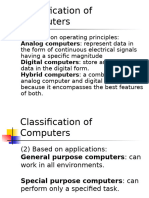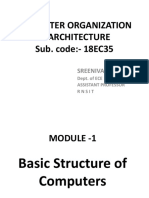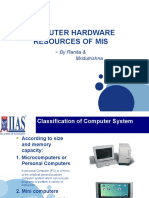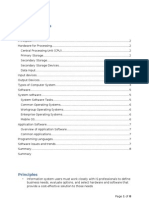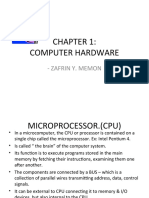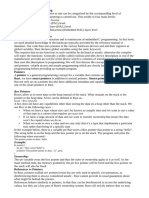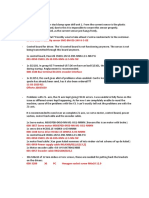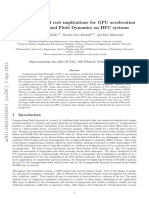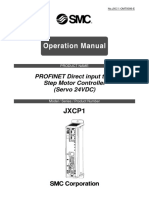Computer Hierarchy
Computer Hierarchy
Uploaded by
acmaCopyright:
Available Formats
Computer Hierarchy
Computer Hierarchy
Uploaded by
acmaOriginal Description:
Copyright
Available Formats
Share this document
Did you find this document useful?
Is this content inappropriate?
Copyright:
Available Formats
Computer Hierarchy
Computer Hierarchy
Uploaded by
acmaCopyright:
Available Formats
Computer Hierarchy
The first generation of computers, from 1946 to about 1956, used vacuum tubes to store and process information.
The second generation of computers, from 1957 to 1963, used transistors for storing and processing information.
Third-generation computers, from 1964 to 1979, used integrated circuits for storing and processing information.
Early to middle fourth-generation computers, from 1980 to 1995, used very-large-scale integrated (VLSI) circuits to store
and process information.
Late fourth-generation computers, from 1996 to the present, use grand-scale integrated (GSI) circuits to store and process
information.
Computer Categories
Mainframe Computers
Midrange Computers
Workstations
Notebooks and Desktop Computers
Appliances
Hardware
Hardware refers to the physical equipment used for the input, processing, output and storage activities of a computer
system.
Central processing unit (CPU) manipulates the data and controls the tasks performed by the other components.
Primary storage internal to the CPU; temporarily stores data and program instructions during processing.
Secondary storage external to the CPU; stores data and programs for future use.
Input technologies accept data and instructions and convert them to a form that the computer can understand.
Output technologies present data and information in a form people can understand.
Communication technologies provide for the flow of data from external computer networks (e.g. the Internet and
intranets) to the CPU, and from the CPU to computer networks.
How the CPU Works
The Central Processing Unit
Central processing unit (CPU) performs the actual computation or number crunching inside any computer.
Microprocessor made up of millions of microscopic transistors embedded in a circuit on a silicon chip.
Control unit sequentially accesses program instructions, decodes them and controls the flow of data to and from the ALU,
the registers, the caches, primary storage, secondary storage and various output devices.
Arithmetic-logic unit (ALU) performs the mathematic calculations and makes logical comparisons
Registers are high-speed storage areas that store very small amounts of data and instructions for short periods of time
How the CPU Works
Binary form: The form in which data and instructions can be read by the CPU only 0s and 1s.
Machine instruction cycle: The cycle of computer processing, whose speed is measured in terms of the number of
instructions a chip processes per second.
Clock speed: The preset speed of the computer clock that times all chip activities, measured in megahertz and gigahertz.
Word length: The number of bits (0s and 1s) that can be processed by the CPU at any one time.
Bus width: The size of the physical paths down which the data and instructions travel as electrical impulses on a computer
chip.
Line width: The distance between transistors; the smaller the line width, the faster the chip.
Advances in Microprocessor Design
Moores Law is that microprocessor complexity would double every two years as a result of the following changes:
Increasing miniaturization of transistors.
Making the physical layout of the chips components as compact and efficient as possible.
Using materials for the chip that improve the conductivity (flow) of electricity.
Targeting the amount of basic instructions programmed into the chip.
Microprocessors & Microcontrollers
The two most common microprocessor architectures are complex instruction set computing (CISC) and reduced instruction
set computing (RISC).
Microcontrollers are computer chips, embedded in products and technologies, that usually cost less and work in lessdemanding applications than microprocessors.
Computer Memory
Two basic categories of computer memory: Primary storage and secondary storage.
Primary stores small amounts of data and information that will be immediately used by the CPU.
Secondary stores much larger amounts of data and information (an entire software program, for example) for
extended periods of time.
Memory Capacity
Bit: Short for binary digit (0s and 1s), the only data that a CPU can process.
Byte: An 8-bit string of data, needed to represent any one alphanumeric character or simple mathematical operation.
Hierarchy of Memory Capacity
Kilobyte (KB): approximately one thousand bytes.
Megabyte (MB): approximately one million bytes (1,048,576 bytes, or 1,024 x 1,024).
Gigabyte (GB): actually 1,073,741,824 bytes (1,024 x 1,024 x 1,024 bytes).
Terabyte: One trillion bytes.
Petabyte: Approximately 10 bytes.
Exabyte: Approximately 10 bytes.
15
18
Primary Storage
Primary storage or main memory stores three types of information for very brief periods of time:
Data to be processed by the CPU;
Instructions for the CPU as to how to process the data;
Operating system programs that manage various aspects of the computers operation.
Primary storage takes place in chips mounted on the computers main circuit board, called the motherboard.
Four main types of primary storage: register, random access memory (RAM), cache memory and read-only
memory (ROM).
Main Types of Primary Storage
Registers: registers are part of the CPU with the least capacity, storing extremely limited amounts of instructions
and data only immediately before and after processing.
Random access memory (RAM): The part of primary storage that holds a software program and small amounts
of data when they are brought from secondary storage.
Cache memory: A type of primary storage where the computer can temporarily store blocks of data used more
often.
Read-only memory (ROM): Type of primary storage where certain critical instructions are safeguarded; the
storage is nonvolatile and retains the instructions when the power to the computer is turned off.
Flash memory: A form of rewritable read-only memory that is compact, portable, and requires little energy
Secondary Storage
Memory capacity that can store very large amounts of data for extended periods of time.
It is nonvolatile.
It takes much more time to retrieve data because of the electromechanical nature.
It is cheaper than primary storage.
It can take place on a variety of media
Magnetic tape: A secondary storage medium on a large open reel or in a smaller cartridge or cassette.
Sequential access: Data access in which the computer system must run through data in sequence in order to
locate a particular piece.
Magnetic disks: A form of secondary storage on a magnetized disk divided into tracks and sectors that provide
addresses for various pieces of data; also called hard disks.
Hard drives: A form of secondary storage that stores data on platters divided into concentric tracks and sectors,
which can be read by a read/write head that pivots across the rotating disks.
Direct access: Data access in which any piece of data be retrieved in a nonsequential manner by locating it using
the datas address.
Magnetic diskettes: A form of easily portable secondary storage on flexible Mylar disks; also called floppy disks.
Optical Storage Devices
Optical storage devices: A form of secondary storage in which a laser reads the surface of a reflective plastic
platter.
Compact disk, read-only memory (CD-ROM): A form of secondary storage that can be only read and not written
on.
Digital video disk (DVD): An optical storage device used to store digital video or computer data.
Fluorescent multilayer disk (FMD-ROM): An optical storage device with much greater storage capacity than
DVDs.
More Storage Options
Memory cards: Credit-card-size storage devices that can be installed in an adapter or slot in many personal
computers (i.e. memory sticks, thumb drives).
Expandable storage devices: Removable disk cartridges, used as backup storage for internal hard drives of PCs.
Enterprise Storage Systems & RAID
Enterprise storage system: An independent, external system with intelligence that includes two or more storage
devices.
Redundant arrays of independent disks (RAID): An enterprise storage system that links groups of standard hard
drives to a specialized microcontroller that coordinates the drives so they appear as a single logical drive.
Storage Area Networks (SANs)
Storage area network (SAN): An enterprise storage system architecture for building special, dedicated networks
that allow rapid and reliable access to storage devices by multiple servers.
Storage over IP: Technology that uses the Internet Protocol to transport stored data between devices within a
SAN; sometimes called IP over SCSI or iSCSI.
Network-Attached Storage
Network-attached storage (NAS) device is a special-purpose server that provides file storage to users who
access the device over a network; plug-and-play.
Input and Output Technologies
Input technologies allow people and other technologies to put data into a computer. The two main types of
input devices are:
human data-entry devices include keyboards, mouse, trackball, joystick, touchscreen, stylus and voice
recognition;
source-data automation devices input data with minimal human intervention (e.g. barcode reader).
Speed up data collection;
Reduce errors;
Gather data at the source of a transaction or other event.
Output generated by a computer can be transmitted to the user over several output devices and media.
Includes monitors, printers, plotters and voice
Multimedia Technology
Multimedia technology is the computer-based integration of text, sound, still images, animation and digitized
motion video.
Merges capabilities of computers with televisions, VCRs, CD players, DVD players, video and audio recording
equipment, music and gaming technologies.
Emerging Technologies
Grid computing involves applying the resources of many computers in a network to a single problem at the same
time.
Utility computing (also called subscription computing and on-demand computing) is when a service provider
makes computing resources and infrastructure management available to a customer as needed for a charge
based on specific usage rather than a flat rate.
Nanotechnology refers to the creation of materials, devices and systems at a scale of 1 to 100 nanometers
(billionths of a meter).
You might also like
- AXI Protocol QuestionsDocument5 pagesAXI Protocol Questionskarthikp20783% (6)
- Lect5 HardwareDocument22 pagesLect5 HardwareHgfdgNo ratings yet
- Computer HardwareDocument36 pagesComputer HardwareChirag RavaniNo ratings yet
- Essential Concepts: Lesson 3Document40 pagesEssential Concepts: Lesson 3Aditya NemaNo ratings yet
- Is Chapter 2Document77 pagesIs Chapter 2LENCHO MAHAMMEDNo ratings yet
- Overview and Organization of Computers BDocument27 pagesOverview and Organization of Computers Bprolearnsolutions786No ratings yet
- Hardware Designed To Meet The NeedDocument67 pagesHardware Designed To Meet The NeedAlvin NardoNo ratings yet
- Week 4Document94 pagesWeek 4lilibethsantillan15No ratings yet
- Comp HardwareDocument29 pagesComp HardwareRanz MonterdeNo ratings yet
- 28999497Document55 pages28999497abhishekbkd26No ratings yet
- Information Systems, Tenth Edition: Hardware: Input, Processing, andDocument55 pagesInformation Systems, Tenth Edition: Hardware: Input, Processing, andOm AffandyNo ratings yet
- Mba Lec2 3Document41 pagesMba Lec2 3api-3844312No ratings yet
- CS AssgmentDocument8 pagesCS AssgmentbnmNo ratings yet
- Python I Unit MaterialDocument19 pagesPython I Unit Materialbalupersonal224No ratings yet
- Lecture 2Document59 pagesLecture 2Marc Jimwell QuesadaNo ratings yet
- Computer Memory HierarchyDocument24 pagesComputer Memory HierarchyNavjot DuaNo ratings yet
- Hardware and Mobile DevicesDocument23 pagesHardware and Mobile Devicesagung darmawanNo ratings yet
- (IT-WK02) Computer HardwaresDocument46 pages(IT-WK02) Computer HardwarespershantNo ratings yet
- Major Hardware Components of A Computer SystemDocument21 pagesMajor Hardware Components of A Computer SystemgiameaeeNo ratings yet
- CS1311A Lecture 3 - Computer HardwareDocument21 pagesCS1311A Lecture 3 - Computer Hardwarepolokomota17No ratings yet
- Lecture TwoDocument35 pagesLecture TwoYoung UtherNo ratings yet
- Information TechnologyDocument97 pagesInformation TechnologySia P.LNo ratings yet
- Chapter 1 Computer Hardware - Part 2Document44 pagesChapter 1 Computer Hardware - Part 2abinissri rajamuniswaranNo ratings yet
- ICT Lecture 02updatedDocument58 pagesICT Lecture 02updatedUzair Ali ZahidNo ratings yet
- 11 cs unit 1 one shot_240427_202128 (1)Document56 pages11 cs unit 1 one shot_240427_202128 (1)gitashree nayakNo ratings yet
- ITMmod 1Document39 pagesITMmod 1prabal parasharNo ratings yet
- TOPIC - 1 MicroprocessorDocument38 pagesTOPIC - 1 MicroprocessorPrevenaManiamNo ratings yet
- Lecture - 3 - HW ComponentsDocument16 pagesLecture - 3 - HW ComponentsAbhishek kumarNo ratings yet
- 1 Introduction To Computers: Components of A Computer SystemDocument52 pages1 Introduction To Computers: Components of A Computer SystemPavithran ThannimalaiNo ratings yet
- 02-The System Unit-Chapter 2Document60 pages02-The System Unit-Chapter 2Shan ZafarNo ratings yet
- 1 Mr.S.M.Raut Computer MemoryDocument19 pages1 Mr.S.M.Raut Computer MemorySandy_82No ratings yet
- W1and2 Components of Computer SystemDocument50 pagesW1and2 Components of Computer SystemRuth Grace CabanligNo ratings yet
- IT Lec 8Document29 pagesIT Lec 8Play StoreNo ratings yet
- Unit-I Introduction to MicroprocessorDocument17 pagesUnit-I Introduction to Microprocessormanalipatik471No ratings yet
- Computer Awareness 1Document61 pagesComputer Awareness 1chandumenswear3No ratings yet
- Know Your ComputerDocument37 pagesKnow Your ComputerNishad.K.SaleemNo ratings yet
- Computer Hardware: Ref: Chapter 3 - MIS by O'Brien, Marakas, & Behl, 9 EdDocument38 pagesComputer Hardware: Ref: Chapter 3 - MIS by O'Brien, Marakas, & Behl, 9 EdAratrika ChoudhuryNo ratings yet
- Introduction To Computer: A Device That Processes Input and Generates OutputDocument17 pagesIntroduction To Computer: A Device That Processes Input and Generates OutputKRUPALI RAIYANINo ratings yet
- Classification of ComputersDocument102 pagesClassification of ComputershimelranasweetNo ratings yet
- 1a IntroCompDocument57 pages1a IntroCompUvanesNo ratings yet
- W5 InputOutput NetworkDocument46 pagesW5 InputOutput NetworkRuth Grace CabanligNo ratings yet
- Elements AssignmentDocument8 pagesElements AssignmentrudraboinavigneshNo ratings yet
- Introduction To ComputerDocument66 pagesIntroduction To Computerstudentinfo121No ratings yet
- Information TechnologyDocument35 pagesInformation TechnologyPavi ThranNo ratings yet
- Fundamentals of Hardware and SoftwareDocument102 pagesFundamentals of Hardware and SoftwareTeck IsmaelNo ratings yet
- Mod 1Document78 pagesMod 1Pratheeksha GowdaNo ratings yet
- Computer Hardware Resources of Mis: by Ranita & MridutrishnaDocument12 pagesComputer Hardware Resources of Mis: by Ranita & MridutrishnaRanita GhoshNo ratings yet
- Module 1Document47 pagesModule 1Ver Laurence CuevasNo ratings yet
- Introduction To It 2018Document53 pagesIntroduction To It 2018dhfbbbbbbbbbbbbbbbbbhNo ratings yet
- Computer Science and The Foundation of Knowledge ModelDocument95 pagesComputer Science and The Foundation of Knowledge ModelTeover RamosNo ratings yet
- Lesson 1: Computer FundamentalsDocument50 pagesLesson 1: Computer Fundamentalsquan DONo ratings yet
- IFS13 Chapter 2Document8 pagesIFS13 Chapter 2RaakwysNo ratings yet
- PSUCDocument517 pagesPSUCshreyanshu.8705No ratings yet
- Module 1Document48 pagesModule 1vigneshvane200No ratings yet
- ICT CS101 Week2Document40 pagesICT CS101 Week2sana.fatimah19No ratings yet
- 11 cs unit 1 one shot_240427_202128 (1)Document56 pages11 cs unit 1 one shot_240427_202128 (1)gitashree nayakNo ratings yet
- Computer Hardware: - Zafrin Y. MemonDocument31 pagesComputer Hardware: - Zafrin Y. MemonzafrinmemonNo ratings yet
- IT FOR BUSSINESS COMPUTER ARCHITECTUREDocument19 pagesIT FOR BUSSINESS COMPUTER ARCHITECTUREphyscokoobraNo ratings yet
- AN 124 User Guide For FT PROGDocument43 pagesAN 124 User Guide For FT PROGodragosNo ratings yet
- UserManual MAR3528Document4 pagesUserManual MAR3528miguel sdNo ratings yet
- ENG DS 2339712-1 Deutsch Solid Contacts 1023Document52 pagesENG DS 2339712-1 Deutsch Solid Contacts 1023ZorbanfrNo ratings yet
- HP Vectra PIe8Document3 pagesHP Vectra PIe8dustycircuitsboyNo ratings yet
- MIMXRT1170EVKHUGDocument20 pagesMIMXRT1170EVKHUGvishwahlifestyleNo ratings yet
- Quick User Manual: E-Rad Blu Electronic SeriesDocument8 pagesQuick User Manual: E-Rad Blu Electronic SeriesDeivid BezerraNo ratings yet
- Oracle Exadata Database Machine Field Delivery Support Consultant Online AssessmentDocument32 pagesOracle Exadata Database Machine Field Delivery Support Consultant Online AssessmentRajiv PatelNo ratings yet
- 120 ServiceDocument39 pages120 ServiceVladimirShimkoNo ratings yet
- Embedded Rust ProgrammingDocument5 pagesEmbedded Rust ProgrammingluksNo ratings yet
- Tugas Bhs IngDocument4 pagesTugas Bhs IngapriliaNo ratings yet
- Modicon PLC 984-38X System, Planning, InstallationDocument70 pagesModicon PLC 984-38X System, Planning, InstallationlllleonellllNo ratings yet
- Instrumentation Cable & Installation Material SpecDocument2 pagesInstrumentation Cable & Installation Material Specriank5266No ratings yet
- Microprocessor and Microcontroller: Chapter 02: AVR ArchitectureDocument21 pagesMicroprocessor and Microcontroller: Chapter 02: AVR ArchitectureMuhammad Anas 484-FET/BSEE/F18No ratings yet
- 10-Lab ManualDocument44 pages10-Lab Manualtankdhruvik800000No ratings yet
- STC89C51RC FeaturesDocument14 pagesSTC89C51RC FeaturesWilliam lopexNo ratings yet
- Lista de Ci Equivalentes Substitutos PDFDocument10 pagesLista de Ci Equivalentes Substitutos PDFErick AlsonNo ratings yet
- Polyuprotec Several Issues V630 VB1050Document7 pagesPolyuprotec Several Issues V630 VB1050hanuarNo ratings yet
- MPMC QuestionsDocument2 pagesMPMC QuestionsDr.R.RAMANNo ratings yet
- CSS 10 Week 3 Activity Sheets or Module NewDocument11 pagesCSS 10 Week 3 Activity Sheets or Module NewKirk TyroneNo ratings yet
- E-Series - E1000-Series Cable Guide BDocument31 pagesE-Series - E1000-Series Cable Guide BpremchandarNo ratings yet
- Winphlash User Guide PDFDocument12 pagesWinphlash User Guide PDFairpwnNo ratings yet
- Speed, Power and Cost Implications For GPU Acceleration of Computational Fluid Dynamics On HPC SystemsDocument12 pagesSpeed, Power and Cost Implications For GPU Acceleration of Computational Fluid Dynamics On HPC Systemsbakular.mark675No ratings yet
- Jxcp1: PROFINET Direct Input Type Step Motor Controller (Servo 24VDC)Document87 pagesJxcp1: PROFINET Direct Input Type Step Motor Controller (Servo 24VDC)Enrique CabreraNo ratings yet
- Simulator PPC PDFDocument31 pagesSimulator PPC PDFMary Ram HerNo ratings yet
- A Complete Guide of Every Type of Computer PortDocument7 pagesA Complete Guide of Every Type of Computer Portdrex.cipher0357No ratings yet
- The Life of StevejobsDocument33 pagesThe Life of StevejobsVipulNo ratings yet
- HP Envy x360 13-Ay0045auDocument1 pageHP Envy x360 13-Ay0045auviitpuneofficial2023No ratings yet
- An Introduction To Microprocessor Systems - Microprocessors, Microprocessor Controlled Systems (PDFDrive)Document89 pagesAn Introduction To Microprocessor Systems - Microprocessors, Microprocessor Controlled Systems (PDFDrive)ALBERTNo ratings yet
- Esxi vs. Esx: A Comparison of Features: Prepared By: The Esx Team and Vmware CommunitiesDocument5 pagesEsxi vs. Esx: A Comparison of Features: Prepared By: The Esx Team and Vmware CommunitiesAmeer SyedNo ratings yet


